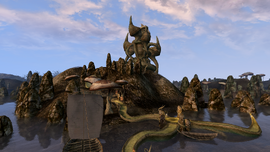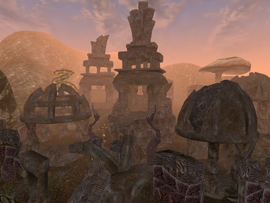
Vvardenfell Architectural Styles describes all the different types of buildings and constructions, that can be found during the events of The Elder Scrolls III: Morrowind on Vvardenfell, the island located in the middle of Tamriel's province of Morrowind.
Background[]
Many different cultures meet in Vvardenfell, the native Dunmer, the Imperials, the Nords and many more brought very different styles of habitats, temples and functional buildings, as can be observed throughout the island. This also includes ancient Daedric ruins, Dwemer citadels, nomad camps, Redoran towns, Imperial towns, the strikingly unique mushroom towers of the Telvanni wizards and the capital of Vvardenfell, Vivec City.[1]
Dunmer settlements[]
Vivec City[]

the High Fane
Vivec City presents a unique panorama of high Dunmer architectural style. Grand multi-tiered cantons are arranged along canals. The cantons have monumental pyramid-like architecture, many bridges connects them. Large buttresses run from the waterline to the roofs. High bridges also lead across the canals, connecting temples and plazas found at the top of the cantons. The whole city, a Dunmer-made island, advances in the Inner Sea, where Vivec's Palace and the Archcanon's High Fane can be seen.[2]
Great Houses[]
The three Dunmer great houses that have settled Vvardenfell have distinctive architectures and lifestyles.
House Redoran[]
The aristocratic Great House Redoran favors a spacious, organic building style, often resembling the shells of very large insects as seen in Ald'ruhn, they are located generally in the central and north-western regions of Vvardenfell.[1]
House Hlaalu[]

Great House Hlaalu, a mercantile power, influenced by Imperial culture, prefers plain, modern habitats, usually located in the south-western regions, as can be seen in Balmora.[1]
House Telvanni[]
The Telvanni sorcerer lords live in their wizard towers that dominate mushroom hut villages. These are usually found on the eastern side of Vvardenfell, on the Azura's Coast, as can be seen in Sadrith Mora or Tel Fyr.[1]
Temples and manors[]
The main religion in vvardenfell is the Tribunal Temple,[3] which has its headquarters in mainland Morrowind and in Vivec city, is represented in most towns by a temple. These temple compounds feature high walled outer courtyards and halls clustered around the Temple shrine as can be seen in Vos. Compounds and residences in the plantations of the Great Houses are similar to the temple compounds with walled outer courts and buildings for craftsmen and servants, dominated by a grand manor residence as can be seen in the Dren Plantation. In the plantations, the manor houses serves as central feature.
Dunmer towns[]

The Dunmer villages are common in Vvardenfell's regions. As can be seen in Gnisis, huts are built of local materials, that must resist the harsh weather conditions of the island. Having organic curves inspired by the shells of giant native insects, like the Silt Strider or in the case of the Redoran headquarters, Ald'ruhn-under-Skar, which is built inside an ancient giant crab shell.[4] Villages are usually dominated by temple compounds and courtyards.
Imperial towns and castles[]

Towns[]
Imperial style of buildings in their settlements is usually simple, sturdy buildings made of stone bricks, with Thatch roofs. Houses, shops, and tradehouses are of timbered, half timbered construction in the Western manner, with right angles and flat planes, and plain, undecorated exteriors, as can be seen in Caldera or Pelagiad.
Fortified Castles[]
The imperial castles, guard towers and fortifications are often on higher grounds and are made of large plain stonewalls, with tall towers as can be seen in Ebonheart or Tel Vos.
Dwemer Ruins[]

- "I wondered what secrets remained hidden in the maze of chambers that lay before me, (...) waiting to gleam again in the light they had not seen in long eons."
- ―Rolard Nordssen[src]
The Dwemer's abandoned citadels dot the landscape of Vvardenfell. Only certain sections of the building are apparent above ground. Often bridges and many walls lie in ruin scattered around the rest of the building. Pipes run in every directions along the walls, that are decorated with lines of carved Daedric letters. Giant cogs, mechanical apparatus and mechanisms are an integral part of these citadel's architecture. The walls are made of a bronze-like metal and large carved stones.[5] Most doors are round and small, they are often composed of long winding corridors, halls and domed rooms as can be seen in Nchardahrk or Mzuleft.
Daedric shrines[]

Daedric shrines are strangely named and shaped buildings that can be found across the Dunmer Island, few dare venture close to them.[6] The outside sections are often lying in ruins. The shrines are made of blocks of dark grey and black rocks. Completely covered in unusual decorative carvings. They usually have one tilted oval door that leads into dark corridors, and large halls. In the center of these ruins, often lies a large statue of one of the Daedric princes. All walls are, also, black and covered in strange carvings, with irregular jagged shapes protruding dangerously in any directions as can be seen in Assurnabitashpi or Onnissiralis. Some are offshore, sunken or half-sunken at the bottom of the sea.
Ashlanders[]

the Ashlanders, the ancient tribal Dunmer people, who still live as nomads, in their yurts.[6] Theses simple round large tents, that are made of darkened beast skins and fabric, usually, house each ashlander in their own yurt, some of the larger ones are shared. The inside is decorated with hanging carpets and decorative shields, there are colorful lamps illuminating the room. A fire usually lies in the center of the yurt, surrounded by bedrolls as can be seen in the Erabenimsun Camp or the Urshilaku Camp.
Gallery[]
Trivia[]
- Often, the inside of a building does not correspond to its outside shape.



